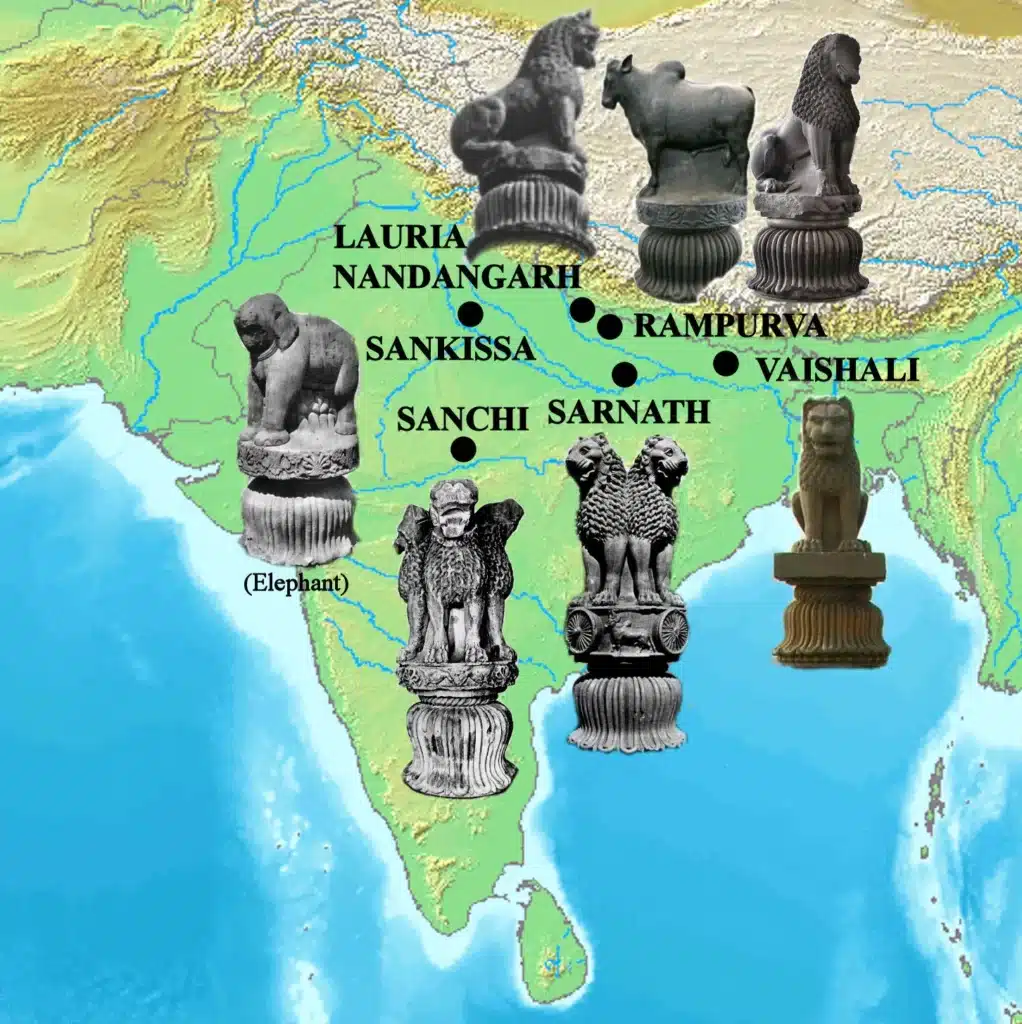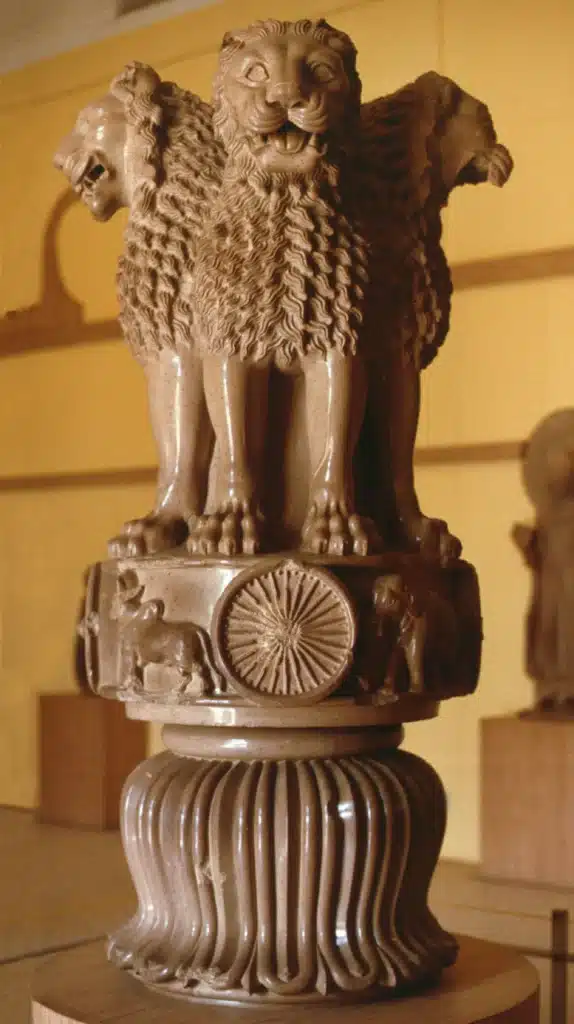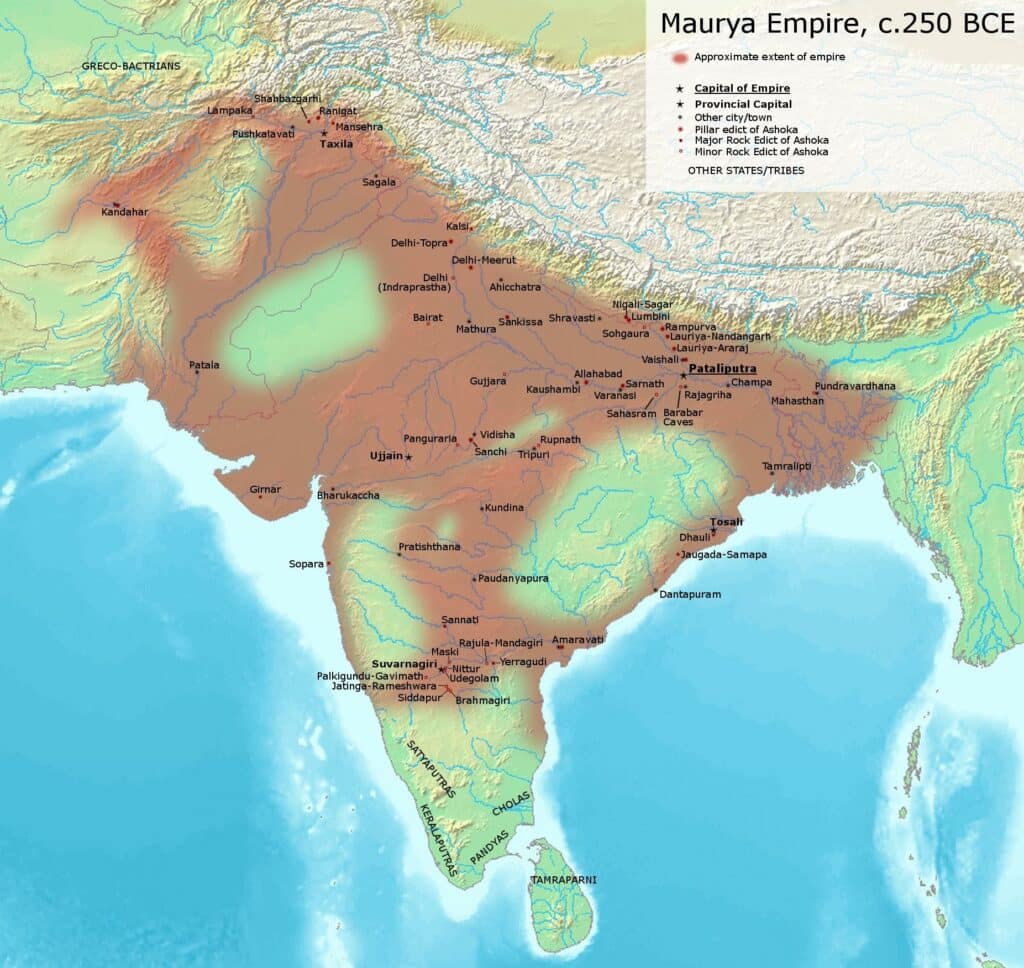- A pillar is any isolated, vertical structure used in architecture or construction to serve an aesthetic or structural purpose in a building. They are often referred to as a pier, column, or post and can be built from a wide array of materials, including wood, stone, or bricks.
- They are an important element of architecture , asethetics and source of history of ancient and medieval India. The earliest example of existing pillars could be dated back to the Mauryan era i.e around 250 BC and especially under the reign of king Ashoka. However some structures similar to pillars existed even before that in the Iron age ( circa 1500BC) which were found at the burial sites like a memorial to mark the places where the dead were buried. Also, before the Ashokan era there existed pillars similar to that of the Ashokan pillars and which was used by the king for putting his inscriptions on.
- Pillars were mainly erected for the following purposes :
- To mark the religious sacredness of a place
- To act as a memorial for the dead at their burial sites.
- To act as supporting structures for houses , temples , palaces
- To commemorate important events of the era like victory of a king in a battle, presence of an important historic personality etc. ( dvajastambha and kirtistambha)
- To act as a medium of mass communication for the population via inscribing messages, laws, rules for the masses.
- They marked the Buddhist sacred places mainly during the reign of Emperor Ashoka in the Ancient Age and during the Gupta Period. Stambha is actually the circular column or shaft slightly tapering towards the top, inverted lotus shaped base is present on the top of the pillar. Crowning sculpture rests on the base present on the summit of the pillar.
- All the three portions namely the circular column, base on the column and crowning sculpture on the base are built of the single type of stone.
- Few of the finest samples of Stambhas or Ashoka Pillars present in India are the Saranath Stambha with its four lions as its crowning sculpture. Famous Iron pillar which is standing without any rust depicts the mastery of Indian metal-casting in the Ancient Age.
Pillar Architecture: Indus Valley Civilization
- The earliest example of pillar architecture comes from the Harappan civilization. Two kinds of pillars having found at the Harappan settlement. One is a stone pillar having measurement that was found at Dholavira (Gujarat). This pillar is probably used to check the water level in the reservoir.
- Pillars made up of bricks were used by Harappan in their houses. These pillars are square/rectangular in shape. These are simple. Their only purpose was to support the roof. The Mesopotamian people used round pillars in their houses.
- The citadel consisted of larger pillars but their role was also supportive.
Pillar Architecture: Mahajanapada
- Fort Building took place
- Pillars were used to support the structure of the Building
- Not much remains are found
Pillar Architecture: Mauryan’s Pillars
- Mauryan Pillars (4th and 2nd Century BC) are one of the crucial architectural belongings of Ancient India. These pillars give details about the major incidents of those times, rulers, wars, etc. Thus, they are major sources of information for Historians.
- Three types of pillars were made during the Mauryan period. The 1st variety was that of a wooden pillar. These pillars were used in the palace build by Chandra Gupta Maurya. These pillars are known only from literacy reference.
- The other 2 varieties of pillars were made up of stone. Out of these 1st variety was used in the stone palace build by Ashoka to support the roof & 2nd variety represented Independent work.
- Despite the fact that creating pillars is an ancient practice, Mauryan pillars vary from pillars in other regions of the globe (such as Achaemenian pillars) in that they are rock-cut pillars, demonstrating the carver’s talent.
- Two kinds of stone were used to chisel these pillars. Some are made of white sandstone from the Mathura region, while others are made of buff-colored fine-grained hard sandstone mined in Chunar near Varanasi.
- The pillar capitals’ similarity in style implies that they were carved by workers from the same location.
- Capital is the topmost element of a pillar or column. Figures such as a bull, lion, elephant, and others were carved onto the upper half of the pillar. The capital figures (typically animals) are all carved standing on a square or circular abacus and are all forceful.
- Abacuses have stylized lotuses on them.
- The Lion Capital, a Mauryan pillar capital unearthed at Sarnath, is the best specimen of Mauryan sculpting tradition.
- King Ashoka erected many pillars across his territory.
- The pillars of Ashoka are a series of monolithic columns dispersed throughout the Indian subcontinent, erected or at least inscribed with edicts by the Mauryan Emperor Ashoka during his reign from c. 268 to 232 BCE.
- Ashoka used the expression Dhaṃma thaṃbhā (Dharma stambha), i.e. “pillars of the Dharma” to describe his own pillars. These pillars constitute important monuments of the architecture of India, most of them exhibiting the characteristic Mauryan polish.
- Of the pillars erected by Ashoka, twenty still survive including those with inscriptions of his edicts.
- Only a few with animal capitals survive of which seven complete specimens are known. Two pillars were relocated by Firuz Shah Tughlaq to Delhi. Several pillars were relocated later by Mughal Empire rulers, the animal capitals being removed.
- Averaging between 12 and 15 m (40 and 50 ft) in height, and weighing up to 50 tons each, the pillars were dragged, sometimes hundreds of miles, to where they were erected.
- All the pillars of Ashoka were built at Buddhist monasteries, many important sites from the life of the Buddha and places of pilgrimage. Some of the columns carry inscriptions addressed to the monks and nuns. Some were erected to commemorate visits by Ashoka.
- Major pillars are present in the Indian States of Bihar, Uttar Pradesh, Madhya Pradesh and some parts of Haryana.
- The capital without the crowning wheel and the lotus base has been adopted as the National Emblem of Independent India.
Construction of Ashokan Pillars
- The traditional idea that all were originally quarried at Chunar, just south of Varanasi and taken to their sites, before or after carving, “can no longer be confidently asserted”, and instead it seems that the columns were carved in two types of stone. Some were of the spotted red and white sandstone from the region of Mathura, the others of buff-colored fine grained hard sandstone usually with small black spots quarried in the Chunar near Varanasi.
- The pillars have four component parts in two pieces: the three sections of the capitals are made in a single piece, often of a different stone to that of the monolithic shaft to which they are attached by a large metal dowel. The shafts are always plain and smooth, circular in cross-section, slightly tapering upwards and always chiselled out of a single piece of stone.
- There is no distinct base at the bottom of the shaft. The lower parts of the capitals have the shape and appearance of a gently arched bell formed of lotus petals.
- The abaci are of two types: square and plain and circular and decorated and these are of different proportions.
- The crowning animals are masterpieces of Mauryan art, shown either seated or standing, always in the round and chiselled as a single piece with the abaci. Presumably all or most of the other columns that now lack them once had capitals and animals. They are also used to commemorate the events of the Buddha’s life.
Pillar Edicts and Inscriptions
The seven pillar edicts of Ashoka have been discovered in Topra (Delhi), Meerut, Kausambhi, Rampurva, Champaran, and Mehrauli:
- Asoka’s idea of people protection is enshrined in Pillar Edict I.
- Pillar Edict II: Defines Dhamma as having the least sins, the greatest number of virtues, compassion, liberality, honesty, and purity.
- Pillar Edict III: Removes sins such as harshness, cruelty, rage, and pride, among others.
- Pillar Edict IV: Addresses the responsibilities of Rajukas.
- Pillar Edict V: A list of animals and birds that should not be slaughtered on certain days, as well as a separate list of species that should not be killed at all.
- Dhamma policy is the sixth pillar edict.
- Asoka’s work towards Dhamma policy is documented in Pillar Edict VII.
Minor Pillar Inscriptions
- Inscription on the Rummindei Pillar: Asoka’s visit to Lumbini and the exemption of Lumbini from taxation.
- Inscription on the Nigalisagar Pillar in Nepal: Asoka extended the height of Buddha Konakamana’s stupa to twice its original size.
Major Pillar Inscriptions
- Sarnath Lion Capital was erected by Ashoka in Varanasi to commemorate Dhammachakrapravartana or Buddha’s first discourse.
- Single lion on Vaishali Pillar in Bihar, with no inscription.
- Uttar Pradesh’s Sankissa Pillar
- Champaran, Bihar: Lauriya-Nandangarth.
- Champaran, Bihar: Lauriya-Araraj
- Uttar Pradesh’s Allahabad pillar.


Pillars without Ashokan inscriptions
- There are also several known fragments of Ashokan pillars, without recovered Ashokan inscriptions, such as the Ashoka pillar in Bodh Gaya, Kausambi, Gotihawa, Prahladpur (now in the Government Sanskrit College, Varanasi), Fatehabad, Bhopal, Sadagarli, Udaigiri-Vidisha, Kushinagar, Arrah (Masarh) Basti, Bhikana Pahari, Bulandi Bagh (Pataliputra), Sandalpu and a few others, as well as a broken pillar in Bhairon (“Lat Bhairo” in Benares) which was destroyed to a stump during riots in 1908.
- The Chinese monks Fa-Hsien and Hsuantsang also reported pillars in Kushinagar, the Jetavana monastery in Sravasti, Rajagriha and Mahasala, which have not been recovered to this day.

Lion Capital, Sarnath
- Sarnath Lion Capital is the name given to the lion capital unearthed more than a century ago at Sarnath, near Varanasi.
- It was created by Ashoka in memory of ‘Dhammachakrapravartana,’ or Buddha’s first discourse, and is one of the best specimens of Mauryan sculpture.
- It was originally made up of five parts:
- The shaft of the pillar.
- The lotus bell, also known as the base.
- A clockwise rotation of four animals on a drum on the bell base (abacus).
- Four magnificent addorsed (back to back) lions.
- Dharamchakra/Dharmachakra, is the highest crowning element.
- Four Asiatic lions are placed back to back in the capital, with very powerful facial muscularity, symbolizing strength, courage, pride, and confidence.
- The sculpture’s surface is highly polished, as is typical of the Mauryan era.
- A chakra (wheel) is shown in all four directions on the abacus (drum on the bell base), with a bull, a horse, an elephant, and a lion between each chakra. There are 24 spokes in each chakra. The Indian National Flag has this 24-spoke chakra.
- An inverted lotus capital supports the circular abacus. The National Emblem of Independent India is the capital without the shaft, the lotus bell, and the crowning wheel.
- Only three Lions are visible in Madhav Sawhey’s insignia, with the fourth obscured from view.
- The abacus is likewise arranged such that just one chakra is visible in the center, with the bull on the right and the horse on the left.


| Asokan Pillars | Persian Pillars |
|---|---|
| Shaft→ Monoliths | Composite→ Joining of different pieces |
| Outer surface→ Smooth | Outer surface→ Grooves |
| Bell at top | Bell at top and bottom |
| Erected without any base | Erected on bell shaped base |
| Used for inscriptions/edicts | Used for supporting roof |
| Independent constructions | Part of palaces, not much evidence of Independent construction |
| Animal capital | Animal capital + Human capital |
| Polish was used even in the pottery – Northern Black Polished ware 6-8th century BCE | Glossy polish was used from 6th century BCE onwards |
